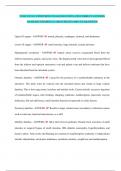NURS 5315 G1 ENDOCRINE EXAM QUESTIONS AND CORRECT ANSWERS
(ALREADY GRADED A+) (2024 UPDATE) 100% GUARANTEED
Upper GI organs - ANSWER- mouth, pharynx, esophagus, stomach, and duodenum
Lower GI organs - ANSWER- small intestine, large intestine, rectum and anus
Hepatoportal circulation - ANSWER- hepatic artery receives oxygenated blood from the
inferior mesenteric, gastric, and cystic veins. The hepatic portal vein receives deoxygenated blood
from the inferior and superior mesenteric vein and splenic vein and delivers nutrients that have
been absorbed from the intestinal system
Osmotic diarrhea - ANSWER- Caused by the presence of a nonabsorbable substance in the
intestines. This pulls water by osmosis into the intestinal lumen and results in large volume
diarrhea. This is how mag citrate, lactulose and miralax work. Causes include: excessive ingestion
of nonabsorbable sugars, tube feedings, dumping syndrome, malabsorption, pancreatic enzyme
deficiency, bile salt deficiency, small intestine bacterial overgrowth or celiac disease
Secretory diarrhea - ANSWER- Results in large volume losses secondary to infectious causes
such as rotavirus, bacterial enterotoxins, or c-diff.
Motility diarrhea - ANSWER- AKA short bowel syndrome. Results from resection of small
intestine or surgical bypass of small intestine, IBS, diabetic neuropathy, hyperthyroidism, and
laxative abuse. Fatty stools and bloating are common in malabsorption syndrome. Complications
include: dehydration, electrolyte imbalance, metabolic acidosis, weight loss and malabsorption.
, Upper GI bleed - ANSWER- bleeding that occurs in the esophagus, stomach or duodenum
commonly caused by bleeding varices, peptic ulcers or Mallory-Weiss tear(tearing of esophagus
from stomach) Characterized by frank, bright red or coffee ground emesis.
Lower GI bleed - ANSWER- Bleeding in the jejunum, ileum, colon or rectum from
inflammatory bowel disease, cancer, diverticula or hemorrhoids. Hematochezia, or the presence of
bright red blood in the stools, suggest a lower GI bleed usually in the rectum, sigmoid colon or
descending colon
Peptic Ulcer Disease - ANSWER- Is a break in the integrity of the mucosa of the esophagus,
stomach or duodenum resulting in exposure of the tissue to gastric acid. Risk factors include
smoking, advanced age, NSAID use, ETOH, chronic disease, acute pancreatitis, COPD, obesity,
socioeconomic status, gastrinoma, and infection with Helicobacter pylori. S&S: Epigastric pain is
worse with eating, melena or hematemesis
Duodenal ulcers - ANSWER- most common and tend to develop in younger patients. S&S:
epigastric pain that is relieved by food. Patients may have melena(black and tarry stool) or
hematemesis
Ulcerative colitis (UC) - ANSWER- Inflammatory disease of the large instestine in persons 20-
40y/o. Less common in people who smoke. Has periods of remission and exacerbations.
Characterized by inflammation and ulcerations that remain superficial and in the small intestine.
UC S&S - ANSWER- recurrent diarrhea, bloody stools, febrile, polyarthritis, uveitis,
sclerosing cholangitis, erythema nodosum and pyoderma gangrenosum




